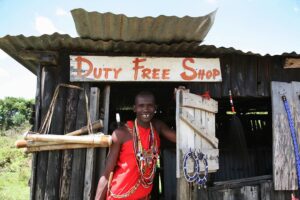Dr Boreham’s Crucible: This cervical cancer detector is globally respected – we know this much is TRU

Truscreen has prestige on its side, says Tim Boreham. Will that be enough to see it succeed? Pic: supplied
This one’s deeply on the quiet, but Truscreen’s (ASX:TRU) CEO Marty Dillon’s most trusted source of geographic intel is the CIA World Fact Book, which has all the juice on even the most obscure countries.
The tome is publicly available: it’s not encrypted or written in invisible ink.
Ironically, Dillon relies on the US spy agency’s information repository because Truscreen has a decidedly non-US focus.
That’s rare for a medical device developer, given the US is a sizeable affluent market with ready reimbursement.
A cervical cancer assay that does not rely on laboratories for diagnosis, Truscreen targets developing countries via government-funded screening programs.
The company has a foothold in the three most populous countries: India, China and Indonesia (the US being the fourth).
“There is a need for a screening solution without the massive investment,” Dillon says.
“Screening methods that don’t require lab facilities for cervical cancer diagnostics can solve the accessibility challenges in developing countries, as they are an alternative to traditional Pap smear tests.”
Truscreen last week launched a NZ$3 million ($2.75 million) capital raising to further its rollout ambitions.
Striving for convenience …
A non-invasive algorithm-based tool, Truscreen Ultra detects cervical cancer with a claimed accuracy at least on par with standard Pap smears and liquid-based cytology (LBC). (Pap tests are named after the Greek inventor Dr Georgios Papanikolaou.)
The device does not need laboratory infrastructure or highly trained staff, which makes it suitable for low and middle income (developing) countries.
Truscreen Ultra detects abnormalities in the cervical tissue in real-time, by measuring via optical and electrical stimuli.
Truscreen Ultra won European Conformité Européenne (CE) mark approval in 2017 and in that year Truscreen made its first commercial sale – in China.
The device is registered in 20 countries including Australia, New Zealand, China, the UK, Saudi Arabia, Russia, Mexico, Indonesia and Zimbabwe.
Approvals are pending in Uzbekistan (see below).
To date, more than one million women have been screened with the device.
Currently almost 90% of Truscreen’s revenue derives from China, by way of distributor Beijing Siweixiangtai Technology Co.
The current reach is across six provinces with a female population of 496 million and a screening population of 124 million.
“China always was our first chosen market because of its size and because they don’t have a national screening infrastructure,” says Dillon.
… and accuracy
Truscreen claims a sensitivity (ability to detect the disease) of 83.3%, compared with 66.7% for a Pap smear and a specificity (ability to discount false positives) of 95% compared with 98.2% for the ‘Paps’.
Dillon says the superior accuracy is accentuated in ‘real world’ conditions, in which liquid-based cytology (LBC) procedures might be compromised by improper laboratory handling and sample transportation.
Dillon dubs the test as “population agnostic”, as the results are consistent across geographies and ethnicities. But cervical cancer is more prevalent in geographies with poorer health systems, while women with HIV are more likely to develop the disease.
Deploying algos and A.I. ahead of their time
Truscreen was once known as the ASX-listed Polartechnics, which developed the first iteration of the screening device with Sydney University and the CSIRO.
The original device was registered in 2005.
“We were one of the world’s first algorithm-based cervical cancer screening devices and one of the first ever using artificial intelligence,” Dillon says.
Polartechnics went into receivership in 2019.
In 2013, a cabal of Kiwi investors acquired the technology from the secured creditors and created Truscreen, which listed on the New Zealand bourse in August 2014 and then on the ASX in 2020.
Dillon joined the company in 2006 in a commercial role before being appointed CEO. He took a break from 2020, before returning in March 2024 for his second stint as commander in chief.
In April, the company marked the death of NZ gynaecologist Prof Ron Jones, who played a key role in developing the predecessor device, Cervical Polar Probe.
Revenue model
In developing markets, patients have less ability to pay and there is usually no reimbursement.
Not to worry.
Truscreen operates only via local distributors, who buy the device and the disposables and make their money in several ways.
One is to sell the device into a government hospital (which may charge the patient a fee) or provide it free to them on the proviso they buy the disposable sensors.
Of course, something for free is not valued as much, so the users who pay for the device tend to deploy it more often.
There’s also a market for private clinics.
“We work with the distributor on how they can break into other [markets], but they are the experts,” Dillon says.
The margins vary from country to country and are volume-based, with the company striving to make the tests available at a patient price of around US$20.
Passage to India
In late April, the company said it had re-entered the Indian market post-pandemic via distributor, Renovate Biologicals.
Cervical cancer screening covers only 2% of the populace, with these seven million annual tests privately funded.
One Indian woman dies from the disease every eight minutes.
India arguably is the second most populated country, with a screening population of 468 million women.
Arguably? Some demographics boffins reckon India has overtaken China.
But Truscreen goes by the CIA’s numbers showing China has a population of 1.416 billion, just ahead of India’s 1.409 billion.
This month, China’s Hangzhou Dalton Bioscience (Dalton) appointed Truscreen as the Indian distributor of its in-vitro diagnostic, for human papillomavirus (HPV).
Dalton makes DNA-based HPV tests, as well as laboratory equipment for cervical cancer screening.
Truscreen notes that co-testing its eponymous artificial intelligence (A.I.)-powered test with the HPV assay has increased the effectiveness of its own test.
A Chinese study showed a co-testing sensitivity rate of 98.4% compared with Truscreen’s “already impressive” stand-alone 87.5%.
Covering the world
In April, the company began a five-year screening program in Vietnam’s largest city, Ho Chi Minh City.
Call it a gift to the nation to mark the 50th anniversary of the liberation of Saigon (the city’s old name which endures for some).
A partnership with the Ho Chi Minh City Public Health Association and distributor Gorton Health Services, the program aims to screen 260,000 women.
Vietnam targets 60% coverage of women aged between 30 and 54, compared with 25% currently.
In Mexico, distributor Sunbird SA de CV is focusing on health check-up clinics in Mexico City, with the potential for up to 20 devices to be installed.
In Indonesia, the world’s biggest Islamic nation, the company is in advanced discussion with a Javanese health clinic and a medical products distributor, with first sales targeted for the current quarter.
In Zimbabwe, Truscreen is participating in a Ministry of Health tender for cervical cancer screening in Harare and regional areas.
Truscreen has sold units in Rwanda and Jordan and the company also is eyeing entry into Thailand, Malaysia, Singapore and Poland.
Uzbekistan beckons
Dillon highlights the company’s prospects in the former Soviet republic of Uzbekistan, where Truscreen has been chosen for a planned national screening program.
The process has been delayed, but the company hopes to get the ball rolling later this year, across an initial 14 clinics.
Uzbekistan is an ‘especially interesting” market as it involves a direct-to-government approach, rather than via distributors. This means the company is dealing directly with the office of the President and health authorities.
According to the CIA’s not-so-top-secret data, Uzbekistan has a population of 36.5 million, with 18 million women and an addressable market of 11.6 million females between the age of 15 and 65 years.
Financials and performance
The capital raising comes at a fortuitous juncture, given Truscreen’s cash had dwindled to NZ$365,473 at the end of March.
The NZ$3 million raising is through an executed institutional placement for $A1.63 million and a share purchase plan to bring in up-to $A1.119 million.
Of the 107,034,091 placement shares, 80.9 million can be issued now, with the remainder subject to approval at a shareholder meeting scheduled for July 11.
The price for both stanzas is 2.0 cents a share, a 23% discount to the prevailing value.
All the shares have an attached option also exercisable at 2.0 cents over the next 12 months.
Truscreen reported product revenue of NZ$1.71 million for the year to March 2025, down 19%. The research and development tax offset brought in another NZ$383,236.
The company lost NZ$2.24 million compared with a previous NZ$2.05 million deficit.
Management attributed the decline to delays in its Vietnam and Zimbabwe rollouts, as well as tardy product registration in Indonesia and Uzbekistan.
The company flags current year revenue of NZ$2.8 million.
Of last year’s revenue, 88% derived from China, with Mexico accounting for a further 7.0%.
In the current year, the company expects China’s revenue share to decline to 63% – not because sales there are falling, but because other geographies are ramping up.
Truscreen shares have traded in a narrow band over the last year, having peaked at 2.9 cents on April 23 this year and troughed at 1.5 cents on July 1 last year.
Dr Boreham’s diagnosis
Cervical cancer is a leading cause of female mortality, especially in countries lacking population-wide screening programs.
The World Health Organisation (WHO) says 600,000 women are diagnosed annually – a rate of more than one a minute.
Truscreen Ultra has won endorsement from respected health bodies, including the WHO (no, not the band) and UNITAID (encompassing the Clinton Health Access Initiative and Australia’s Daffodil Foundation).
Truscreen’s mission is in sync with the WHO target of eliminating cervical cancer by the end of the century.
Okay, that’s a few years away but the agency targets 70% global coverage of screening and 90% treatment of pre-cancerous lesions by the end of 2030.
We don’t get carried away with gongs, but Truscreen last year was selected by a respected Austrian research house as one of six companies that will impact global women’s health, from a cohort of 580 companies.
Of course, all this amounts to a hill of beans if the company can’t translate this recognition into sales traction, soon.
After all, you can’t eat prestige. But with the company claiming to be at the “turning point” of commercialisation, investors may enjoy a more varied diet.
At a glance
ASX & NZX code: TRU
Share price: 2.2 cents
Shares on issue: 554,907,719*
Market cap: $12.2 million
CEO: Martin Dillon
Board: Tony Ho (chair), Juliet Hull, Chris Horn, Dr Dexter Cheung
Financials* (full year to March 2025): revenue NZ$1.71 million (down 19%), total revenue NZ$2.1 million (down 19%), net loss NZ$2.29 million (NZ$2 million deficit previously), cash of NZ$365,000
Major identifiable holders*: NZ Depositary Nominees 11.5%, NZ Central Securities Depositary 6.23%, Consolidated Nominees 5.3%, Masfen Securities 5.26%, Bhagwanji Bhula Rama 5%, Ryan Parker 3.26%, Kevin and Vikki Ho 2.9%
* Ahead of up-to NZ$3 million ($A2.75 million) capital raising (NZ$1.00 equals $A0.92)
Disclosure: Dr Boreham is not a qualified medical practitioner and does not possess a doctorate of any sort. He has eaten prestige before, but it left him with an empty feeling.

UNLOCK INSIGHTS
Discover the untold stories of emerging ASX stocks.
Daily news and expert analysis, it's free to subscribe.
By proceeding, you confirm you understand that we handle personal information in accordance with our Privacy Policy.








